#Umoja reflection
Explore tagged Tumblr posts
Text
Umoja: Striving for Unity in Personal and Community Relationships
As Kwanzaa begins, we light the first candle on the Kinara and reflect on the principle of Umoja—unity. Umoja calls us to seek harmony in our families, communities, and relationships. It challenges us to examine how we contribute to the bonds that connect us and the ways we may unintentionally weaken them. For me, this reflection brings to light a recent situation where I fell short of embodying…

View On WordPress
#African heritage#building connections#family and community unity#fostering harmony#Kwanzaa principles#Kwanzaa Umoja#personal growth during Kwanzaa#relationship repair#Umoja reflection#unity and community
0 notes
Text
Friday Four: Embracing Kwanzaa: A Soulful Celebration of Unity, Purpose, and Heritage
#and community. Each year#and more#and purpose for my children and our community. Join me as we explore the heart and soul of this meaningful celebration. ✊🏿🌿💫#connection#culture#families come together to honor the seven guiding principles of Umoja (Unity)#I share how celebrating Kwanzaa has become a powerful tradition in our home#Kujichagulia (Self-Determination)#Kwanzaa is more than just a holiday – it’s a vibrant celebration of African heritage#nurturing a deep sense of pride#reflecting on the past while building a brighter future. In this post
2 notes
·
View notes
Text
Kwanzaa:
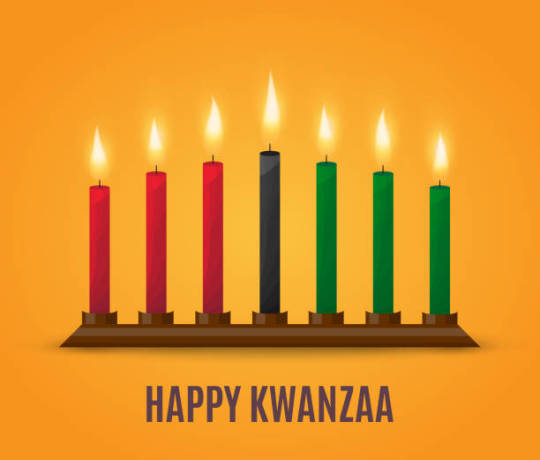
Kwanzaa, an annual holiday celebrated primarily in the United States from December 26 to January 1, emphasizes the importance of pan-African family and social values. It was devised in 1966 by Maulana Karenga, Inspired by Africa’s harvest celebrations, he decided to develop a nonreligious holiday that would stress the importance of family and community while giving African Americans an opportunity to explore their African identities. Kwanzaa arose from the black nationalist movement of the 1960s and was created to help African Americans reconnect with their African cultural and historical heritage. The holiday honors African American people, their struggles in the United States, their heritage, and their culture. Kwanzaa's practices and symbolism are deeply rooted in African traditions and emphasize community, family, and cultural pride. It's a time for reflection, celebration, and the nurturing of cultural identity within the African American community.
Kwanzaa is a blend of various African cultures, reflecting the experience of many African Americans who cannot trace their exact origins; thus, it is not specific to any one African culture or region. The inclusiveness of Kwanzaa allows for a broader celebration of African heritage and identity.
Karenga created Kwanzaa during the aftermath of the Watts riots as a non-Christian, specifically African-American, holiday. His goal was to give black people an alternative to Christmas and an opportunity to celebrate themselves and their history, rather than imitating the practices of the dominant society. The name Kwanzaa derives from the Swahili phrase "matunda ya kwanza," meaning "first fruits," and is based on African harvest festival traditions from various parts of West and Southeast Africa. The holiday was first celebrated in 1966.
Each day of Kwanzaa is dedicated to one of the seven principles (Nguzo Saba), which are central values of African culture that contribute to building and reinforcing community among African Americans. These principles include Umoja (Unity), Kujichagulia (Self-Determination), Ujima (Collective Work and Responsibility), Ujamaa (Cooperative Economics), Nia (Purpose), Kuumba (Creativity), and Imani (Faith). Each family celebrates Kwanzaa in its own way, but Celebrations often include songs, dances, African drums, storytelling, poetry readings, and a large traditional meal. The holiday concludes with a communal feast called Karamu, usually held on the sixth day.
Kwanzaa is more than just a celebration; it's a spiritual journey to heal, explore, and learn from African heritage. The holiday emphasizes the importance of community and the role of children, who are considered seed bearers of cultural values and practices for the next generation. Kwanzaa is not just a holiday; it's a period of introspection and celebration of African-American identity and culture, allowing for a deeper understanding and appreciation of ancestral roots. This celebration is a testament to the resilience and enduring spirit of the African-American community.
"Kwanzaa," Encyclopaedia Britannica, last modified December 23, 2023, https://www.britannica.com/topic/Kwanzaa.
"Kwanzaa - Meaning, Candles & Principles," HISTORY, accessed December 25, 2023, https://www.history.com/topics/holidays/kwanzaa-history.
"Kwanzaa," Wikipedia, last modified December 25, 2023, https://en.wikipedia.org/wiki/Kwanzaa.
"Kwanzaa," National Museum of African American History and Culture, accessed December 25, 2023, https://nmaahc.si.edu/explore/stories/kwanzaa.
"The First Kwanzaa," HISTORY.com, accessed December 25, 2023, https://www.history.com/this-day-in-history/the-first-kwanzaa.
My Daily Kwanzaa, blog, accessed December 25, 2023, https://mydailykwanzaa.wordpress.com.
Maulana Karenga, Kwanzaa: A Celebration of Family, Community and Culture (Los Angeles, CA: University of Sankore Press, 1998), ISBN 0-943412-21-8.
"Kente Cloth," African Journey, Project Exploration, accessed December 25, 2023, https://projectexploration.org.
Expert Village, "Kwanzaa Traditions & Customs: Kwanzaa Symbols," YouTube video, accessed December 25, 2023, [Link to the specific YouTube video]. (Note: The exact URL for the YouTube video is needed for a complete citation).
"Official Kwanzaa Website," accessed December 25, 2023, https://www.officialkwanzaawebsite.org/index.html.
Michelle, Lavanda. "Let's Talk Kwanzaa: Unwrapping the Good Vibes." Lavanda Michelle, December 13, 2023. https://lavandamichelle.com/2023/12/13/lets-talk-kwanzaa-unwrapping-the-good-vibes/.
901 notes
·
View notes
Text

◜🕯️𓂃 Happy Kwanzaa! ‧ 🌽◞
⁺ ◍ . ⁺ ☆ ⁺ . ◍ ⁺
Early Habari Gani to my lovely African American followers! [this post is a day early] I hope each day brings you the best wishes and a joyful and prosperous new year! As a celebrant of Kwanzaa, id love to teach you guys about it too!
⁺ ◍ . ⁺ ☆ ⁺ . ◍ ⁺
★﹒┊How did Kwanzaa form? ⁔⁔
In 1965, a white police officer pulled over two African American men in Watts, Los Angeles, sparking protest from the community. The crowd grew, leading to six days of rioting and violence, resulting in 34 deaths and over a thousand injuries, now known as the Watts Rebellion. Educator and activist Maulanga Karenga wanted to rebuild neighborhoods affected by the Watts Rebellion and encourage pride amongst the people instead! As part of his plan, he created Kwanzaa in 1966 to empower African Americans to rediscover and honor their African roots. It is assumed that kwanzaa was celebrated on the African continent but to a lesser degree
⁺ ◍ . ⁺ ☆ ⁺ . ◍ ⁺
★﹒┊What does Kwanzaa mean? ⁔⁔
Kwanzaa, meaning "first fruits" in Swahili, celebrates the harvest season, and promotes honoring the 7 principles: unity, self-determination, collective work and responsibility, cooperative economics, purpose, creativity, and faith.
⁺ ◍ . ⁺ ☆ ⁺ . ◍ ⁺
★﹒┊How is it celebrated? ⁔⁔
⧼ 🏺 ⧽ Decorations
During Kwanzaa, African heritage symbols are displayed in homes, starting with a mkeka (muh-KAY-kuh) , a traditional woven mat representing traditions like sharing and faith. The mat features meaningful items like a basket filled with fruits and vegetables to represent harvest, corn for each child within your family, and a unity cup called kikombe cha umoja (kee-KOHM-bee cha oo-MOH-jah).
⧼ 🕯️ ⧽ Candles
A big part of celebrating Kwanzaa is marked by the lighting of a new candle each night. An adult pours water or juice from the unity cup onto the ground [to remember family ancestors], which is then passed to each family member while they chant harambee (Swahili for "let’s pull together" and pronounced hah-RAHM-beh) seven times while they sip from the cup. The kinara (kee-NAH-ruh) holds seven candles: one black, three red, and three green, representing unity, the past, and the future. Celebrants light a special candle each day, reflecting on the other six principles of Kwanzaa, and on the first night, celebrants light the black unity candle.
⧼ 🍍 ⧽ Food
Throughout the days of Kwanzaa, there are many celebratory dishes that can be made! Often times, the dishes are made from recipes that have been passed down from generation to generation which regularly are rooted in african culture like peanut soup or shrimp gumbo, topped off with tasty desserts like fried bananas, sweet potato pie, and coconut sweets. The big celebration is on December 31, when family and friends gather for a feast called karamu (kuh-RAH-moo), where we play music, dance, and singing. The last day is quieter, with people focusing on their future success and personal growth.
⁺ ◍ . ⁺ ☆ ⁺ . ◍ ⁺
★﹒┊Kwanzaa Fun ⁔⁔
Before finishing up, i would like to give you guys some Kwanzaa themed worksheets !
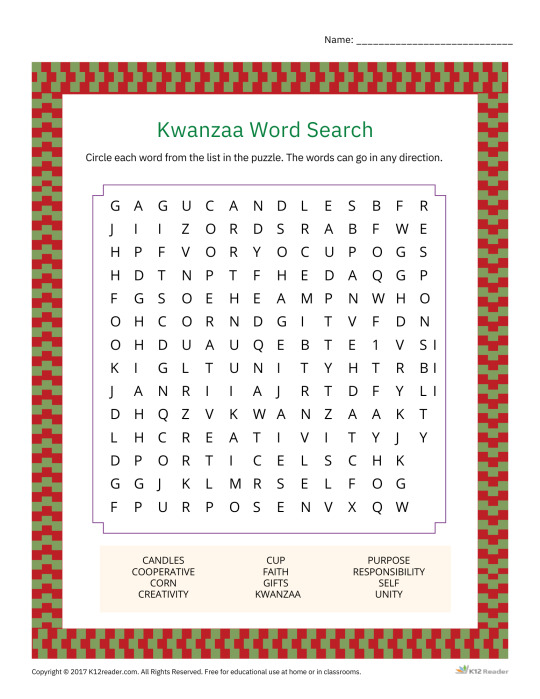
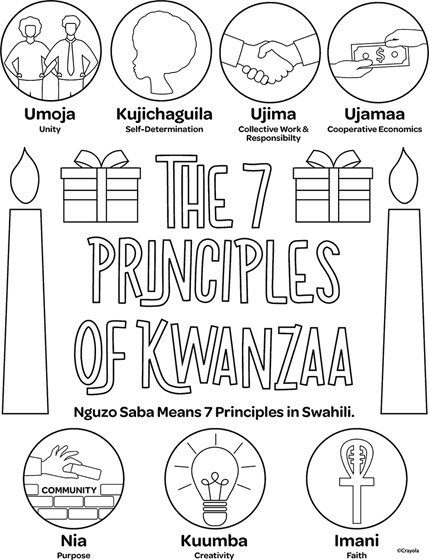
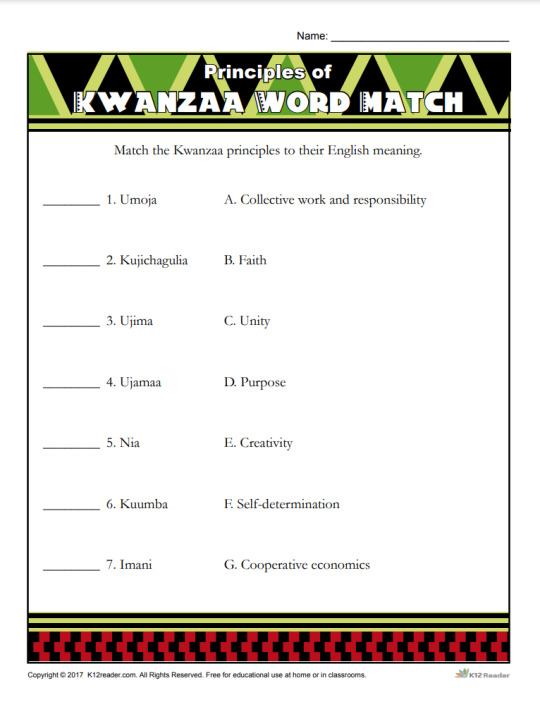
⁺ ◍ . ⁺ ☆ ⁺ . ◍ ⁺
18+ blogs // DD!LG, AB!DL and variants [even "SFW"] // 27 and older // DNI
Fact OTD: Kwanzaa has spread from the U.S. to other areas of the world, and is celebrated among African-Canadians, for example.


#✩⸜⸜babi posts 💫#anti endo#kwanzaa#winter agere#age regression#pet regression#age dreaming#agere#petre#agedre#babyre#therian#alterhuman#age regressor#sfw age regressor#sfw age regression#agere community#age regression community#autistic agere#agere blog#age regression blog#agere cg#babycore#sfw babyre#sfw toddlerre
25 notes
·
View notes
Text

🌟 Joyous Kwanzaa, my friends! Let’s reflect on our shared values of Umoja (Unity), Kujichagulia (Self-determination), and Nia (Purpose) as we celebrate this season of community and culture. 💫
- Leo
17 notes
·
View notes
Text
15 Things to do in Kampala
📍 15 Things to Do in Kampala
1️⃣ Experience Buganda’s royal heritage at the Kasubi Tombs, Kabaka’s Palace, and the Katereke Prison Ditch.
2️⃣ Visit Kampala’s iconic religious sites, from the Bahá'í Temple to Rubaga Cathedral, Namirembe Cathedral, and Old Kampala Mosque.
3️⃣ Discover the artistic vibrancy of Kampala at top galleries like Karibu Art Gallery, Umoja Art Gallery, Uganda Art Gallery, Makerere Art Gallery, AKA Gallery, and the Afriart Gallery
4️⃣ Reflect on courage and faith at the Uganda Martyrs Shrine and Munyonyo Martyrs’ Shrine.
5️⃣ Learn about Uganda’s National history through its national monuments, including the Independence Monument and the World War Memorial Monument.
6️⃣ Go to Uganda National Museum for history and experience live cultural performances at Ndere Cultural Centre.
7️⃣ Explore the city’s vibrant markets, like Owino and Nakasero Markets, and try Uganda’s famous Rolex, the street food you’ll never forget
8️⃣ Experience Kampala’s vibrant nightlife in Kololo and Kabalagala.
9️⃣ Explore the historic Makerere University, one of Africa’s most prestigious institutions, and and visit the Sir Edward Muteesa II Museum which was officially opened in February 2024.
🔟 Take a guided walking or hiking tour of Kampala’s seven famous hills. Highlights include Namirembe Hill, Rubaga Hill, and Makerere Hill, offering a mix of culture, history, and stunning views.
1️⃣1️⃣ Experience the vibrancy of Uganda’s performing arts at the National Theatre or LaBonita Theatre, where traditional dances, plays, and musical performances bring Uganda’s stories to life.
1️⃣2️⃣ Kampala is home to some amazing coffee shops where you can sample Uganda’s world-renowned coffee. Favorites include Endiro Coffee, 1000 Cups, and Good African Coffee.
1️⃣3️⃣ Take a responsible tourism trip with a guided tour of Kisenyi, offering an authentic look into the resilience and daily lives of Kampala’s urban communities.
1️⃣4️⃣ For sports enthusiasts, Lugogo is the hub for cricket, basketball, rugby, and more. It’s also a prime spot for concerts and major festivals in Kampala.
1️⃣5️⃣ Cap off your adventure with a serene sunset cruise on Lake Victoria, the perfect ending to a day in Kampala.
2 notes
·
View notes
Text
Thanks for the tag @carrotcakecrumble I have no idea what this means:

So I put my Walkman on random and picked the first 10:
Ruins, Cat Stevens, Catch Bull at Four
Colegiala, Rudolfo Su Tipica, Best Latino Carnival ever
I Chose Right, John Barrowman, Reflections from Broadway
Forbidden Love, Madonna, Confessions on a Dance Floor
The Click Song, Umoja cast recording
I Got You Babe, The Flying Pickets, Only you
Man of Constant Sorrow (instrumental), Tennessee River Authority, Ramblin' Roads
Gold Rush, Basia Bulat, Heart of my own
For My Lady, Moody Blues, Seventh Sojourn
I believe in Love, Hair original cast recording
Consider yourselves tagged if there is anyone left!!
6 notes
·
View notes
Text

Image: Wangechi Mutu, 'You are my sunshine,' collage painting on paper, 24 x 36", 2015.
“Marginalized and oppressed people are linked to the status of their group and are less likely to be afforded individual status and insulation from the experiences of the groups with which they are identified. The political nature of [search engines] demonstrates how algorithms are a fundamental invention of computer scientists who are human beings–and code is a language full of meaning and applied in varying ways to different types of information” -Safiya Umoja Noble, "Algorithms of Oppression"
Before reading Safiya Umoja Noble’s “Algorithms of Oppression,” I was among the many that truly believed Google was a neutral public resource. Maybe you’ve heard the saying “library at your fingertips.”
However, despite popular belief, its algorithms serve paid advertising which happens to sport search results as a product of “most relevant and useful information” (Noble 37). Algorithms involve the process of “rendering,” a procedure that Noble calls “expressly social, economic, and human,” implemented through a series of steps called “algorithms” (37). The common misconception that Search is a mirror to human beliefs is combatted by Noble’s notion that “current algorithmic constraints [do] not provide appropriate social, historical, and contextual meaning to already overracialized and hypersexualized people who materially suffer along multiple axes” (36).
This means that for the white programmers who are uncomfortable talking about race, accurate depictions of Black, Indigenous, and People of Color escape the clutches of our everyday algorithms.
Furthermore, search engine optimization or SEO represents pushing ads or websites to the “top of a results list for a query,” providing profit to various companies or Google based on website clicks (Noble 40). Because Google is what Noble calls a “multinational advertising company,” it can prioritize search results for, say, “Black women” under a multitude of porn hyperlinks over the “eleven and a half billion documents that could have been indexed” (49).
Even someone such as Noble, who defines herself from the Black feminist perspective, a pedagogy that analyzes the intersection between racism, sexism, and so on, would find that search results do not always directly reflect her interests.
One quote that I would like to include, and that pulls away the smoke screen of “naturalized” algorithms, comes early on in the chapter, “Marginalized and oppressed people are linked to the status of their group and are less likely to be afforded individual status and insulation from the experiences of the groups with which they are identified. The political nature of [search engines] demonstrates how algorithms are a fundamental invention of computer scientists who are human beings–and code is a language full of meaning and applied in varying ways to different types of information” (Noble 26).
Edited: 5/2/2023
8 notes
·
View notes
Text
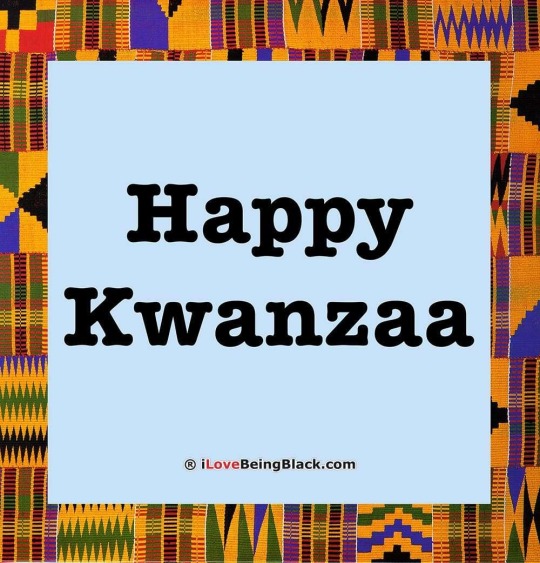
Happy Kwanzaa!
#Kwanzaa is an African American and Pan-African holiday which celebrates family, community and culture. Celebrated from December 26th through January 1st, the origins are in the first harvest celebrations of Africa from which it takes its name. The name Kwanzaa is derived from the phrase "matunda ya kwanza" which means "first fruits" in Swahili, a Pan-African language which is the most widely spoken African language.
Each day is started with this greeting: Habari Gani - What is the news? The reply is the ‘Nguzo Saba’ (principle) for that day. They are listed in order here:
Umoja - Unity
Kujichagulia - Self Determination
Ujima - Collective Work & Responsibility
Ujamaa - Cooperative Economics
Nia - Purpose
Kuumba - Creativity
Imani - Faith
The first-fruits celebrations are recorded in African history as far back as ancient Egypt and Nubia and appear in ancient and modern times in other classical African civilizations such as Ashantiland and Yorubaland. These celebrations are also found in ancient and modern times among societies as large as empires like the Zulu kingdoms (Swaziland) or smaller societies and groups like the Matabele, Thonga and Lovedu, all of southeastern Africa. Kwanzaa builds on the five fundamental activities of Continental African "first fruit" celebrations: ingathering; reverence; commemoration; recommitment; and celebration. Kwanzaa, then, is:
• a time of ingathering of the people to reaffirm the bonds between them;
• a time of special reverence for the creator and creation in thanks and respect for the blessings, bountifulness and beauty of creation;
• a time for commemoration of the past in pursuit of its lessons and in honor of its models of human excellence, our ancestors;
• a time of recommitment to our highest cultural ideals in our ongoing effort to always bring forth the best of African cultural thought and practice; and
• a time for celebration of the Good, the good of life and of existence itself, the good of family, community and culture, the good of the awesome and the ordinary, in a word the good of the divine, natural and social.
Kwanzaa was established in 1966 in the midst of the Black Freedom Movement and thus reflects its concern for cultural groundedness in thought and practice, and the unity and self-determination associated with this. It was conceived and established to serve several functions.
Finally, Kwanzaa is a cultural holiday, not a religious one, thus available to and practiced by Africans of all religious faiths who come together based on the rich, ancient and varied common ground of their Africanness.
Courtesy of:
http://www.officialkwanzaawebsite.org/origins1.shtml
1 note
·
View note
Text

🌟 Happy Kwanzaa! 🎉 Today we celebrate the first day of this beautiful holiday, embracing the principle of Umoja (Unity)! Let’s gather with family and friends, light the kinara, and share our blessings. May this week be filled with love, reflection, & community. Here’s to a joyful Kwanzaa! 🖤🧡💚 #Kwanzaa2024 🌿✨
0 notes
Text
New on TikTok: Marcus Garvey emphasized unity with his motto: "One God. One Aim. One Destiny." Umoja, the first principle of Kwanzaa, reminds us of the power of togetherness in building strong families, communities, and a shared destiny. Garvey’s teachings align with this principle by urging us to recognize that collective strength is the foundation for liberation and progress. @Terrance Friday for the video. Give thanks, Brother! "Daily Garvey Wisdom" offers daily doses of inspiration and motivation drawn from Marcus Garvey's powerful teachings. Each quote highlights the resilience within us and the strength of the Black community, reminding us that with hope and faith, we can overcome any challenge. These reflections encourage us to stay committed, lift each other up, and keep moving forward—just as Garvey envisioned—toward a brighter, more unified future. #marcusgarvey #marcusgarveyquotes #Kwanzaa #Umoja #Unity #MarcusGarvey #OneGodOneAimOneDestiny #Community #AfricanDiaspora Kwanzaa Candle lighting order in an alternating, inward pattern. (Outward pattern video is here: https://youtu.be/DIz0cqHu0ZI) Each candle represents a Principle of the Nguzo Saba: Umoja - Unity (Black candle) Kujichagulia - Self-determination (Red candle) Ujima - Collective work and responsibility (Green candle) Ujamaa - Cooperative economics (Red candle) Nia - Purpose (Green candle) Kuumba - Creativity (Red candle) Imani - Faith (Green candle) Created by: Terrance Friday
http://dlvr.it/TH17d0
0 notes
Text
Reflecting on the Past, Embracing the Future: Kwanzaa’s Final Day and the Principle of Imani
As the last day of Kwanzaa dawns, we reflect on the principle of Imani, which means faith. It’s a time to honor our journey, acknowledge the strides we’ve made, and solidify our belief in a future filled with purpose, connection, and progress. Reflecting on the Year Gone By The past year has been a mosaic of challenges and triumphs. Through perseverance and community, we’ve seen the resilience…
#African heritage#African-American celebrations#collective work#community building#Cooperative Economics#cultural traditions#Dionne#Dionne Lewis#faith#goal setting#heritage and faith#Imani#inspirational#Kujichagulia#Kuumba#Kwanzaa#New Year reflections#Nia#personal Growth#purefilly#Ujamaa#Ujima#Umoja
2 notes
·
View notes
Text

Kwanzaa is an African American celebration that occurs from December 26 to January 1 (Kwanzaa is from January to January), highlighting African culture, unity, and community values. Although many people mistake it for “African Christmas,” Kwanzaa has no religious roots, being a cultural celebration created in 1966 by Dr Maulana Karenga. Your Seven Principles (Nguzo Saba) are core values to strengthen communities and connect people to African heritage. Here is a description of the seven principles:
Umoja (Unidade)
It represents the effort to maintain unity in the family, the community, the nation and the world. It is the foundation for building strong, respectful relationships.
Choose yourself (Autodeterminação)
It means defining, naming, creating, and speaking for oneself, reaffirming personal and community identity without relying on external influences.
Ujima (Work and collective responsibility)
Reflects the importance of community effort to solve problems and achieve common goals, emphasizing that progress of one is progress of all.
Ujamaa ( Economic co-operation )
It focuses on building and sustaining businesses and institutions to benefit the community, promoting self-sufficiency.
Nia ( Purpose )
Encourages commitment to building and developing the community to restore the cultural and historical greatness of the African people.
Kuumba ( Creativity )
Inspire using imagination and skills to improve the community and leave a beautiful and useful legacy for future generations.
Imani (Fé)
It involves belief in oneself, community and collective efforts, plus confidence in a better future based on hard work and determination.
Kwanzaa is a time of reflection, celebration, and hope, rooted in the appreciation of African culture and community bonds.
0 notes
Text
Umoja (unity):
Umoja, the first principle of Kwanzaa, is a powerful concept emphasizing unity within the family, community, nation, and race. The principle, pronounced oo-mo'-ja, is celebrated on the first day of Kwanzaa, which begins on December 26th. It embodies the idea of striving for and maintaining unity, a key aspect of the holiday's focus on family and community bonds.
The Dagi Knot, a Pan-African symbol of unity found in various African cultures such as the Bushongo, Hausa, and Yoruba, is associated with Umoja. This symbol reflects the principle's significance in fostering a sense of togetherness and solidarity.
During the celebration of Umoja, the first candle lit is the black one, representing both the principle of unity and the African-American people. This act of lighting the candle is not only symbolic but also a reaffirmation of the values and goals of the African-American community.
"Kwanzaa," Encyclopaedia Britannica, last modified December 23, 2023, https://www.britannica.com/topic/Kwanzaa.
"Kwanzaa - Meaning, Candles & Principles," HISTORY, accessed December 25, 2023, https://www.history.com/topics/holidays/kwanzaa-history.
"Kwanzaa," Wikipedia, last modified December 25, 2023, https://en.wikipedia.org/wiki/Kwanzaa.
"Kwanzaa," National Museum of African American History and Culture, accessed December 25, 2023, https://nmaahc.si.edu/explore/stories/kwanzaa.
"The First Kwanzaa," HISTORY.com, accessed December 25, 2023, https://www.history.com/this-day-in-history/the-first-kwanzaa.
My Daily Kwanzaa, blog, accessed December 25, 2023, https://mydailykwanzaa.wordpress.com.
Maulana Karenga, Kwanzaa: A Celebration of Family, Community and Culture (Los Angeles, CA: University of Sankore Press, 1998), ISBN 0-943412-21-8.
"Kente Cloth," African Journey, Project Exploration, accessed December 25, 2023, https://projectexploration.org.
Expert Village, "Kwanzaa Traditions & Customs: Kwanzaa Symbols," YouTube video, accessed December 25, 2023, [Link to the specific YouTube video]. (Note: The exact URL for the YouTube video is needed for a complete citation).
"Official Kwanzaa Website," accessed December 25, 2023, https://www.officialkwanzaawebsite.org/index.html.
Michelle, Lavanda. "Let's Talk Kwanzaa: Unwrapping the Good Vibes." Lavanda Michelle, December 13, 2023. https://lavandamichelle.com/2023/12/13/lets-talk-kwanzaa-unwrapping-the-good-vibes/.
6 notes
·
View notes
Link
0 notes
Text
Rabi Mishra’s cartoons on display.
By A Staff Reporter,Kathmandu, Jan. 19: Popular cartoonist Rabi Mishra’s 1st solo cartoon exhibition, titled ‘Depiction,’ has kicked off at Umoja Cafe in NB Centre, Naya Baneshwor, Kathmandu, starting from Thursday.

The 10-day exhibition, running until January 28, showcases Mishra’s first-ever solo collection, featuring around 35 cartoons that have been previously published in various newspapers and magazines over his illustrious career of 17 years.
Mishra, also the general secretary of the Cartoonist Club of Nepal, expressed his belief that cartoons go beyond mere images, they serve as a powerful medium for expressing views, emotions and humor.
“Cartoons are a great means for me to communicate with society,” Mishra remarked, emphasising the significance of satire in his work.
The exhibition highlights Mishra’s unique perspective on current events, societal scenes, characters, trends, and ideas through the lens of satire.Despite engaging in other forms of art, Mishra proudly identifies himself as a cartoonist.
His cartoons challenge and provide commentary on those in positions of power, reflecting his commitment to addressing and disagreeing with prevailing events and ideas in society.
Viewers have the opportunity to watch cartoons that satirise politicians, societal issues and those in power.
Mishara said that he chose to showcase his cartoon exhibition in the open spaces of a mall rather than art galleries.
The aim was to generate awareness among the general audience about the art of cartoons and its significance in society, he added.
The Rising Nepal
Fri, 19 January 2024
1 note
·
View note